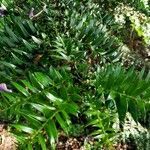Tree to 50 m tall. Adult leaves dimorphic, narrowly triangular to acicular on orthotropic shoots, narrowly triangular on plagiotropic shoots, broadly based, decurrent, spreading and secondarily distichous, 1-5 cm long, 3-10 mm wide, glossy, dark green above, paler below. Juvenile leaves similar, smaller. Male cones cylindrical, sessile, 6-11 cm long, 10-15 mm diam. Female cones terminal on short lateral branches, ovoid, 20-30 cm long, 15-20 cm diam.; bract-scales winged. Seeds ovoid, 20-25 mm long, 15-20 mm diam., shed from scales at maturity.
A large tree. It can be 50 m high. They spread to 10-20 m across. The branches radiate out in a symmetrical fashion. The lowest branches droop towards the ground. The leaves are simple and 2-6 cm long by 0.5-1.5 cm wide. They do not have leaf stalks. The leaves are oval and leathery. They are spiny at the tip. The fruit are large seed cones. They are up to 20-30 cm long by 15-20 cm wide and occur at the ends of twigs. These contain numerous seeds which are up to 5 cm long. The seeds are edible.


